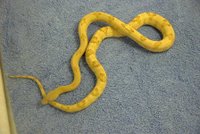Friday, January 27, 2006
Stocklist request letter I wrote at age 14


This monster (me) was created a long time ago. I don't know how we found this at my parents' house, but it's a stocklist request that I wrote to Glades Herp when I was 14 years old in junior high (8th grade).
It turned up as I was going through old documents before Amy and I moved up to Utah last August, and I thought I had to keep this. It's too typical of how I was as a child to throw away, so I thought it best to "immortalize" it on this blog.
Tuesday, January 24, 2006
More beautiful animals from the Mike Price camp...


The normally patterned youngster is an '05 captive-bred from the "Big Hill", a locality not too far from the Panther Canyon in Presidio County. Apparently happy and content with a belly full of mouse.
The blonde animal was a '92 legally wild-collected TPRS from Pepper's Hill; Mike's original male for that bloodline. A lot of nice yellow in that snake. That photo appears in Dick Bartlett's book, "Designer Reptiles and Amphibians - 2002" published by Barron's books on page 49.
Thanks again to Mike for the great photos. If you want a beautiful, locality-specific H-snake, then you can't go wrong with Mike Price.
Friday, January 20, 2006
A few of Mike's '05 hatchout
 A lot of different looks there. I think the topmost animal is the lemon line of blonde? Each blonde there is a different locality, I believe. The normals are also very pretty and are exact locale animals too. Mike sure does produce some nice stuff, doesn't he?
A lot of different looks there. I think the topmost animal is the lemon line of blonde? Each blonde there is a different locality, I believe. The normals are also very pretty and are exact locale animals too. Mike sure does produce some nice stuff, doesn't he?Thursday, January 19, 2006
Lemon and Mustard Yellow Blondes
 The top one was sold on KS a while back to someone unknown to me. The scanned picture is from Bartlett's rat snake book. High yellow blondes are really nice snakes.
The top one was sold on KS a while back to someone unknown to me. The scanned picture is from Bartlett's rat snake book. High yellow blondes are really nice snakes.
Saturday, January 14, 2006
Dave and Tracy Barker's albino suboc chat link
This is a link to a chat the Barker's did on KS a few years back where the topic was on their two albino suboc projects (the Loma Alta and Dave Long bloodlines).
known established albino lines
Although still expensive, $900 is actually a really, really good price for a baby albino female suboc. Considering that there are only about 3 to 5 guys in the world that own an albino adult suboc from the Loma Alta line, a high price is pretty justified. About three years ago, they went for around $2,500 each, and some still go for around $1,200 to $1,500. Adults go for around $2,500 to $3,000.
About the explanation of the different localities of albinos, I could give you a brief synopsis. I already have a page for subocs.com that is more thoroughly written on this topic. There are three established and proven bloodlines, and none of them are compatible when bred to each other. They are as follows:
1. Loma Alta (Hwy. 277) line<---This is the line that Don Soderberg and VPI started together, however Don no longer works with them. The only people I know of that own adults of this line are Dave Katz, Craig Trumbower and myself. I heard that many of Tracy Barker's at VPI have died off. I don't know if they still have a breeding colony.
2. the European line<---This line is the oldest and most established of the three. These don't have a known locality. They hatched serendipitously in a lucky breeder's incubator. The only blondes that are het for albino (so far) have come from this line. The other two lines haven't been around long enough yet. If I was a betting man, I'd run to Las Vegas and bet my last dollar that your blonde male is het for the Euro line.
3. the Dave Long - Brewster County line<---This is a very yellow/orange/golden animal that Dave Long found. Tracy Barker also established this line. She is (or was) the only person to have breedably-sized adults. I don't believe anyone else has adults of these yet.
Todd Smith in California breeds the Euro line, and he has had several hatch this year that are possible hets for albino. He hatched out blondes, silvers of both patterns, and normals that are possible hets for albino. He had atleast one albino hatch. If you were to get a blonde or silver blonde from him, you'd have a fair chance of producing albinos, blondes and even albino blondes. Todd has just about the best prices I have ever seen for subocs. He sells albinos for about $750.
I'm sure you could get a possible het for a really great price.
Wednesday, January 11, 2006
Long lost OOP blonde suboc article and collector's item available for viewing



Authors Bill Lamoreaux and Doug Wuerch provided me with both scanned and Xeroxed copies of this historic article that they wrote while working together at the Dallas Zoo in the late 70's and early 80's. This paper appeared in the Dallas Herpetological Society Occasional Papers 1: 9-13 in 1981, and was the first official and full-length description of the blonde phase. Click on the individual pages to read the fully sized document.
Bill actually went to the trouble for me of going and finding this 25 year old article that has long since been tucked away in files in his basement.
Many thanks to Bill and Doug for their generosity of providing this info.



